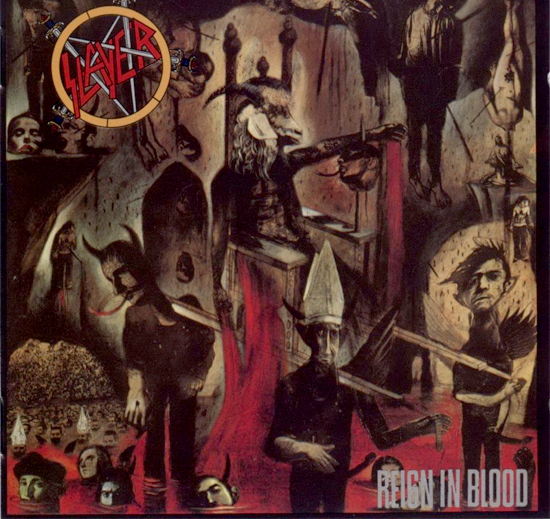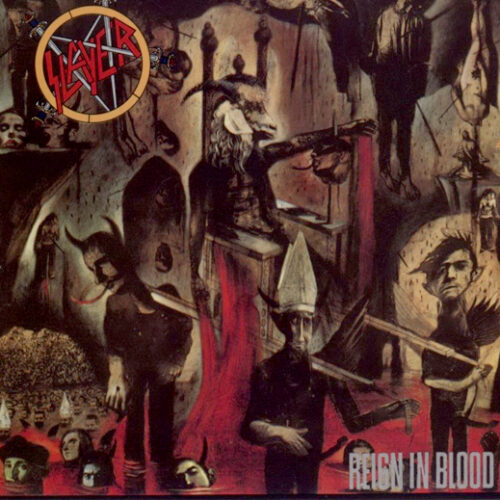This article was originally published in 2011 to mark the album’s 25th anniversary
I was sitting in my parent’s kitchen. I was a teenager with an alarming hunger for extreme metal. My mother came down from my bedroom having presumably cleared a path – like Moses parting the Red Sea – through a chaotic pile of underwear and back-issues of KERRANG! She had stumbled across a vinyl copy of Slayer’s Reign In Blood.
“What… the hell… is this?” she asked.
Back in 1986, new albums just arrived; there was nothing else for them to do. They weren’t leaked, teased, street teamed, twittered about or subject to a weekly studio update; they just came out. In most cases, the only heads-up the metal community got was a few lines in the news section of a metal magazine stating that a band – in this case Slayer – was working on something new: a follow-up to the previous year’s Hell Awaits.
Earlier that year, Master Of Puppets arrived with a similar abruptness. In the minds of most Metallica fans and the press it was an instant success, taking over from 1984’s Ride The Lightning as their best album to date. And not long after – before the studio amps were given time to cool down properly even – it was roundly being hailed as the best thrash album of all time.
In the months after Metallica released their masterpiece, the pressure was piled on Slayer. One of the only bits of factual information we had ahead of release was that the band were working with Rick Rubin, a producer best known for recording hip hop acts like Run DMC and LL Cool J. The signs did not bode well. Rubin was obviously genuinely interested in the group but when you added his rap background to Slayer’s already challenging reputation and lyrics to the fact that Def Jam were owned by the major label Geffen, the signs did not bode well. It was a very conservative period where heavy metal was the national whipping boy, Geffen just weren’t people to take those kinds of risks.
In the end Geffen did get Reign In Blood out there of course – but not before the album’s release date was delayed due to the graphic cover-art and controversial lyrical content. These were attributes which immediately challenged the record buyer’s moral fortitude while no doubt piquing the morbid curiosity of more casual observers.
There is nothing garish or clichéd about Reign In Blood‘s artwork. In fact, unless you look closely at the images and their careful arrangement, you couldn’t say with total confidence what was actually being depicted. On closer inspection however, the vision is a little clearer even if the concept isn’t. Whether Reign In Blood‘s cover art is – as has been often suggested – a snap-shot of Hell itself is irrelevant now. But what the various visages – all of them strangely implacable – do achieve is to offer an unsettling visual parallel to the music itself. These songs, despite often threatening to run off like loose, crazy horses, are delivered with frightening control. They are presented with almost no reverb and zero self-parody, leaving the listener nowhere to hide.
Gone are the cartoonish satanic lyrics on which both Show No Mercy and Hell Awaits were founded. For the most part Reign‘s subject matter deals with real life and those subjects within it that we don’t like acknowledging. Serial killers, disease, religion and perhaps least palatable, initially and still most commonly misunderstood, the acts of Nazi death camp doctor Josef Mengele – in the once-heard-never-forgotten album opener ‘Angel Of Death’. In the face of a shitstorm of pro-Nazi allegations, Slayer were simply holding a mirror up to some of the most appalling acts of humanity in the 20th Century that had rarely been acknowledged before (in popular music at least). Not just that, despite the record’s furious velocity, every single syllable emitted from Tom Araya’s mouth is clearly distinguishable amid a frighteningly aggressive and at times atonal frenzy, all of which makes the records’ many stark messages that little bit more impactful.
The album acts quickly and with clinical precision – 28.56 breathless minutes to be precise and when the needle enters the run-out groove after the terminal thunderclap of ‘Raining Blood’, the only conceivable thing to do is to play the fucking thing again. And again. Everything in between these two book ends – from the bewildering blur of ‘Necrophobic’ to the agonising splendour of ‘Postmortem’ is a master-class in a brand of brutal efficiency, the likes of which had previously been unheard of. Its white-knuckle intensity is unmatched in the genre of heavy metal, despite the frequent and often unexpected tempo changes.
While ‘Angel Of Death’ nauseates with its harrowing narrative and the most intense mid-song breakdown in the history of heavy metal; ‘Piece By Piece’ stabs, chops and slices, like its title suggests: “There’s only one way out of here…” Araya memorably yells, “Piece By Piece!” and with that it’s gone, only two minutes after it arrived. And much like an unstoppable, terminal disease, ‘Epidemic’ methodically takes over from the inside out before rendering the listener utterly helpless and close to death. Then Araya puts us out of our misery by uttering the immortal line: “Death machine infest my corpse to be.”
While everyone has their favourites for all kinds of twisted reasons, it’s perhaps the stunning ‘Reborn’ which – a quarter of a century later – leaves the nastiest taste that 2.12 minutes of music possibly could do: “Death means nothing, there’s no end, I will be reborn.” The defiant parting shot of a convicted witch, underscored by one of the most deranged riffs in Slayer’s history.
With such visceral lyrical outlooks populating every track, no wonder the listener is always looking for breathing space – for momentary respite from an aural representation of life so hellishly unforgiving that it surely can’t be real. But don’t look for comfort somewhere between these grooves. There is simply none to be found. While there is melody buried deep within the deranged guitar howls which only serve to mimic the awful anguish of the song’s various victims, it’s a twisted and perverse form of melody – the kind we crave when we know that we probably shouldn’t.
So, from a metal fan’s perspective, Reign In Blood is as important and evocative as it could get in 1986. And this status would only grow, given the scores of bands and genres who drew influence from its terrifying legacy without ever coming close to replicating its impact – including Slayer themselves. In the fabric of heavy metal it is untouchable, a colossal monument to extremity, economy and sheer sonic terror jammed into just half an hour.
As important as Reign In Blood is to music fans, another barometer is to establish where it sits with fellow musicians, so with that in mind, I asked Philip Anselmo for some of his thoughts on the record’s impact on heavy metal generally.
Philip, how did you first discover Slayer and how did they fit into what you – as a musician – were doing at the time?
Philip Anselmo: I remember watching heavy metal closely as it evolved. I was about 15 years old or so and Metallica’s Kill ‘Em All really set the tone for that kind of metal, with the crunchy axe sound. Slayer’s Show No Mercy was a great LP but it still posed a lot of questions as to where they’d go next. Then, Haunting The Chapel was a much more relentless offering, but still, it was only an EP. Finally, when Slayer released Hell Awaits, I, like many others, was sold. That record is still my favourite. Very Mercyful Fate influenced riff-wise but the point is: Slayer became more extreme, where bands like Metallica were heading in a more acceptable direction. I was a Slayer kid 100%.
Do you remember when you first heard Reign In Blood? Set the scene and tell us what your first thoughts were…
PA: I bought Reign In Blood on vinyl when it first came out. I really had no cash to do much of anything but getting that record was essential… Shit, I probably would have stolen it if it weren’t for a friend lending me the cash to buy it. Anyway, all I had to listen to it on was my buddy’s shitty turntable at the apartment I was living in and it skipped constantly – I was furious! But I eventually got the cassette and all was, well, crushing! There wasn’t a single show I’d go to where RIB wasn’t the talk of the night; it killed everything else even considered ‘heavy’.
Which tracks stand out most and why?
PA: Where do I start? ‘Angel Of Death’, ‘Piece By Piece’, ‘Altar Of Sacrifice’, ‘Jesus Saves’, ‘Criminally Insane’, ‘Raining Blood’. All of them are still brutal masterpieces. Slayer had trimmed down their riffing a tad on RIB, but still, they were complex enough to keep my attention and innovative beyond words. Extreme drumming, extreme vocals, extreme concepts, insane riffing and blistering out of key leads… like Black Flag possessed by a Catholic Satan. Gotta love it…
Did you – consciously or otherwise – take any aspect of RIB forward to Pantera material and if you did, which songs or feels are most heavily influenced?
PA: Of course. But there was a bit of influential magic here. I was the Slayer fan out of the Pantera boys – they were into Metallica, Motorhead and Def Leppard etc, so I was a bit of an outcast. But there was no denying Slayer’s power and their popularity was growing, so it was tough for the fellas to ignore. Slayer was playing on a Saturday night in Dallas on the South Of Heaven tour and they’d gotten into town the night before. My great friend and boxing coach, Mad Maxx Hammer at Z-Rock (who was a DJ at that time) suggested to the Slayer guys that they should come to see us play on that Friday. Well, Tom, Kerry and Jeff came out, and to cut a very long story short, Kerry and I hit it off well. Kerry and Jeff even got up and jammed Reign In Blood with us that night. Several months later, Kerry called me and said that he wanted to come hang out (he was in between legs of touring) and jam with us. That jam session… teaching Dimebag Slayer riffs and Dime teaching Kerry our stuff was stupendously influential. Look no further than the end of ‘Domination’ to hear the Slayer influence, it’s fucking obvious!
Slayer supported Pantera in 2001, what were your emotions having them support you given how you felt about their music?
PA: All I knew was that we had better jam our asses off every night. We really had to be on point. Playing after Slayer is no easy chore and dammit, when they’d kick into ‘Angel Of Death’ or ‘Raining Blood’… my adrenaline still gets going just thinking about it! I’d get so pumped-up watching Slayer that I’d have to catch a second (or third) wind just to get up and play our set. It’s true! Slayer was the craziest motivator ever… and I mean EVER.
Sum up where you think RIB fits into the overall fabric of heavy metal?
PA: It still stands the test of time and still kills – a pure, classic LP. To me, Slayer invented the style of heavy metal I adore: odes to Satan with discordant axe harmonies and thundering drums. They invented the style – that says everything. There may have been other great bands out there – great influential bands – but Slayer stands alone in my heart till I croak, period. And I think history will be kind to them. They’re legends under my roof anyway.



